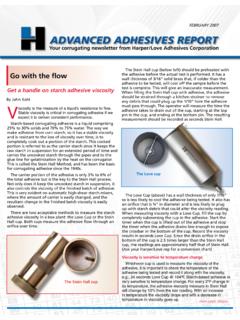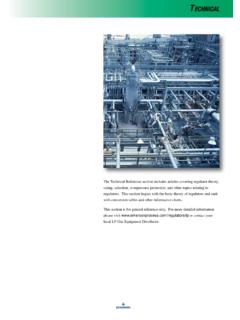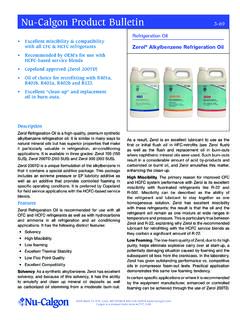Transcription of Universal Viscosity Curve Theory - ftimeters.com
1 Universal Viscosity Curve TheoryTurbine Flow Meters and Flow ViscosityTMTMI ntroductionLike any transducer, a turbine flow meter is sensitive to physical parameters other than the one which is of interest. While designed to measure flow, a turbine meter responds to the Viscosity of a fluid as well as its velocity. Following is a brief discussion of the Viscosity sensitivity of a turbine flow discussion begins with a review of the nature of Viscosity and the means by which it is measured. The characteristics of viscous drag and its action within the turbine meter are also discussed. Following this, there is a description of Universal Viscosity Calibration techniques as a practical means of dealing with the Viscosity sensitivity of turbine meters.
2 Readers familiar with the viscous properties of fluids may wish to begin with the section on Universal Viscosity of Absolute ViscosityAbsolute Viscosity is the characteristic of a fluid which causes it to resist flow. The higher the numerical value of absolute Viscosity assigned to a fluid, the greater the resistance that fluid offers to and gasoline are relatively low Viscosity fluids which flow very easily. Such a low Viscosity fluid is frequently referred to as an approximately inviscid fluid. Motor oil and maple syrup are examples of more viscous fluids which offer far greater resistance to flow. Castor oil and molasses are even more viscous. It is the Viscosity of the molasses which prevents it from running out of the bottle when Viscosity of a fluid causes a loss in pressure as it flows, so that an increase in Viscosity requires an increased amount of energy to pump fluid at the same rate.
3 When it is necessary to cause fluids to flow through small openings, such as in low capacity flow meters, too high a Viscosity can cause so much pressure loss that it becomes impossible to establish the desired flow rate. Expressed another way, flow from a constant pressure source will decrease as the Viscosity of the flowing fluid Viscosity of a liquid is highly temperature dependent. An increase in temperature will cause a decrease in Viscosity . For this reason, it is possible for a temperature change to affect the performance of a flow meter Viscosity DefinedThe absolute Viscosity of a fluid is a measure of its resistance to shear stresses. Shear stresses occur whenever a fluid experiences an angular deformation as it flows. Consider a fluid flowing over a surface as illustrated in Figure 1.
4 Due to Viscosity , the film of fluid next to the surface will be sticking to it and will, therefore, have zero velocity. Fluid further away from the surfacewill be sticking to it and will, therefore, have zero velocity. 01 Universal CalibrationsKinematic and Absolute ViscosityFluid further away from the surface will slip over the fluid beneath it as it moves to the right. Since each successive layer of fluid will slip over the layer below it, the velocity of the fluid will increase with the distance from the surface over which the fluid is then a small cube of fluid as shown at point A in Figure 1. By the time this small cube of fluid gets to B it will have to have deformed as illustrated because the fluid further from the surface is moving faster.
5 This is referred to as angular consider the forces acting between such a cube and a similar cube directly above or below it. Since the two cubes are in effect sliding over each other, there is a force between them resisting this sliding or shearing. If H is the height of the cubes, and V is the difference in velocity between the center of the top cube and the center of the bottom cube, the force between them may be represented by:In differential form, this equality is usually expressed as:assuming that y designates vertical distance. Fluids are said to be Newtonian fluids if the proportionality factor, , is a constant. The constant of proportionality is defined as the absolute Viscosity of the fluid. It is usually identified by the Greek letter ratio between shear forces and the velocity gradient in a fluid (as defined in the previous section) is absolute Viscosity , and is identified with the symbol (Greek letter mu).
6 Because the ratio for absolute Viscosity to density appears in so many engineering equations, a second symbol is assigned to that ratio. The symbol used is v (Greek letter nu). Thus:It is the kinematic Viscosity , v, which is of interest in turbine flow meter applications. Thus, both the absolute Viscosity and the density must be known. Knowing the specific gravity is equivalent to knowing the density. In the metric system, is expressed in centipoise, v is expressed in centistokes, and v = /S, where S is the specific CalibrationsTMViscosity MeasurementViscosity is most commonly measured with rotating cylinder viscometers or capillary tube devices. Rotating cylinder viscometers measure the shear forces associated with a fluid, and thus determine the absolute Viscosity .
7 The absolute Viscosity is usually determined in metric units, which are centipoise. The density of the fluid must then be measured so that the kinematic Viscosity may be obtained. Kinematic Viscosity is expressed in centistokes in the metric system. When absolute Viscosity is expressed in centipoise and density is expressed in gram/cc, the ratio will result in tube viscometers measure kinematic Viscosity directly. This is done by observing the time required for a specific volume of fluid to flow through the capillary tube. Rather than converting the data to centistokes, the raw data itself has been used to establish some Viscosity scales, and they then have units in seconds. The Saybolt Seconds Universal (SSU) is an example of such a Viscosity & PressureThe absolute Viscosity of a fluid is strongly influenced by temperature.
8 As temperature increases, the Viscosity of a liquid decreases and the Viscosity of a gas increases. It is customary to express these relationships as a plot of Viscosity vs. temperature, and such plots can be found in many references for common engineering fluids. Many oils have a straight line characteristic if the Viscosity temperature relationship is plotted as on an ASTM chart (ASTM D-341-43). An example of such a plot is shown in Figure 2 for MIL C-7024B, Type II solvent and MIL H-5606-B Hydraulic Fluid. Because of the temperature dependency of Viscosity , it is important to specify the temperature as well as the service medium for turbine meter influence of pressure on absolute Viscosity is usually neglected, and this approximation is reasonable for low pressures.
9 However, for pressures over about 1000 PSI, the absolute Viscosity of a fluid may be a strong function of pressure. Generally, an increase in pressure will increase the Viscosity of a Viscosity is the ratio of absolute Viscosity and density. Therefore, if density changes with temperature or pressure, the kinematic Viscosity will also change. For gas applications, kinematic Viscosity is a strong function of pressure. Remember kinematic Viscosity is the key fluid parameter that influences the turbine meter CalibrationsTMLaminar & Turbulent FlowFluid flow is characterized as being either laminar or turbulent. In laminar flow the fluid moves in layers, with one sliding smoothly over the other. There is no mixing of fluid from layer to layer, since viscous shear forces damp out relative motions between layers.
10 Since each layer of fluid is in effect flowing over the one adjacent to it, the fluid velocity increases with the distance from the pipe wall. The resulting velocity profile is approximately parabolic in shape. This is illustrated in Figure turbulent flow, there are no discrete layers of flowing liquid. The momentum of the fluid overcomes the viscous shear forces, and there is extensive and continual mixing across the flow stream. This causes the velocity profile across a pipe to be nearly flat. This is illustrated in Figure measure of the laminar or turbulent nature of flow is the Reynolds Number (Re). By definition:The numerator in the Reynolds Number is directly related to the momentum possessed by the fluid. The denominator is the absolute Viscosity of the fluid, and is therefore, directly related to the shear forces existing in the fluid.





